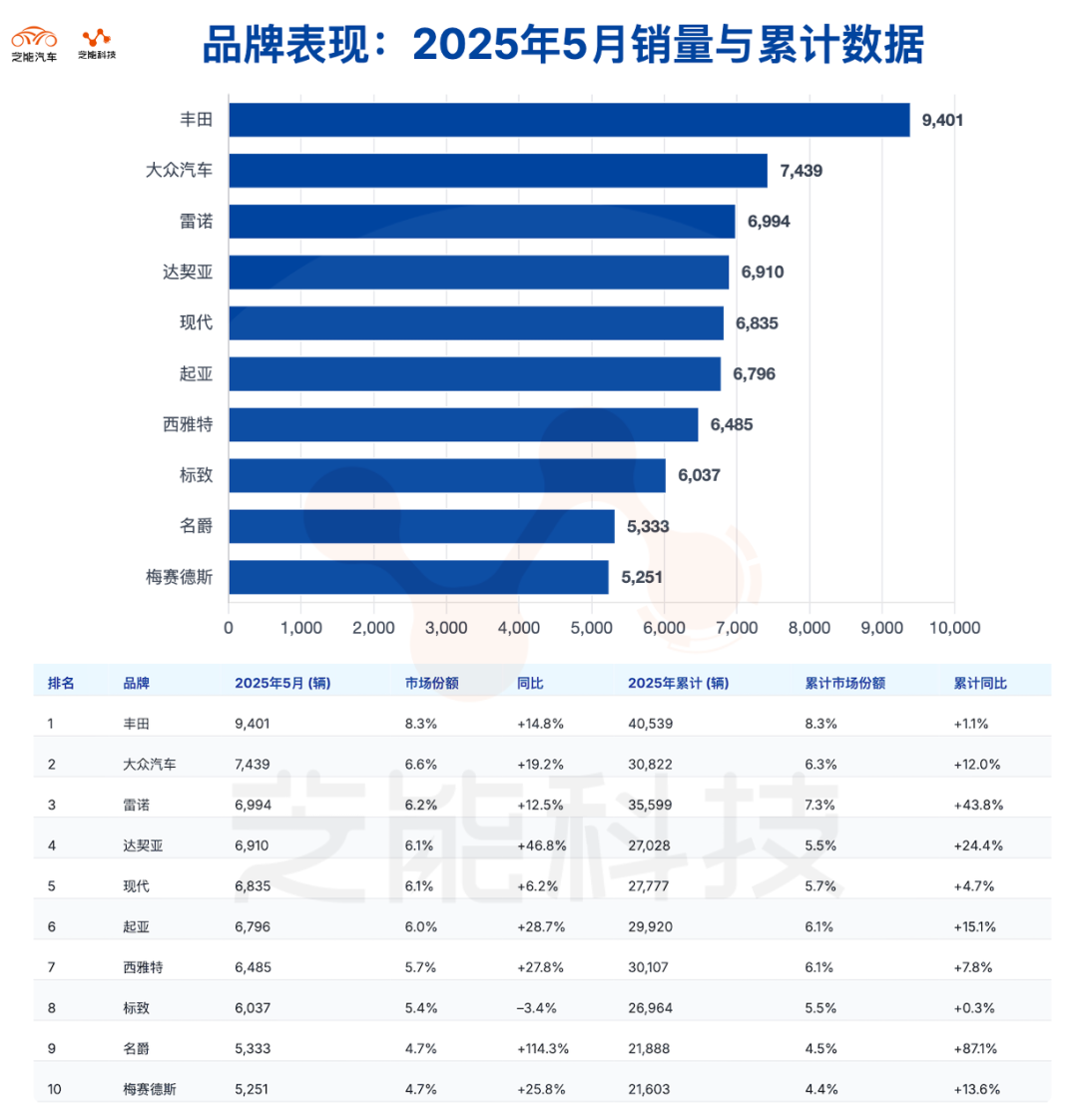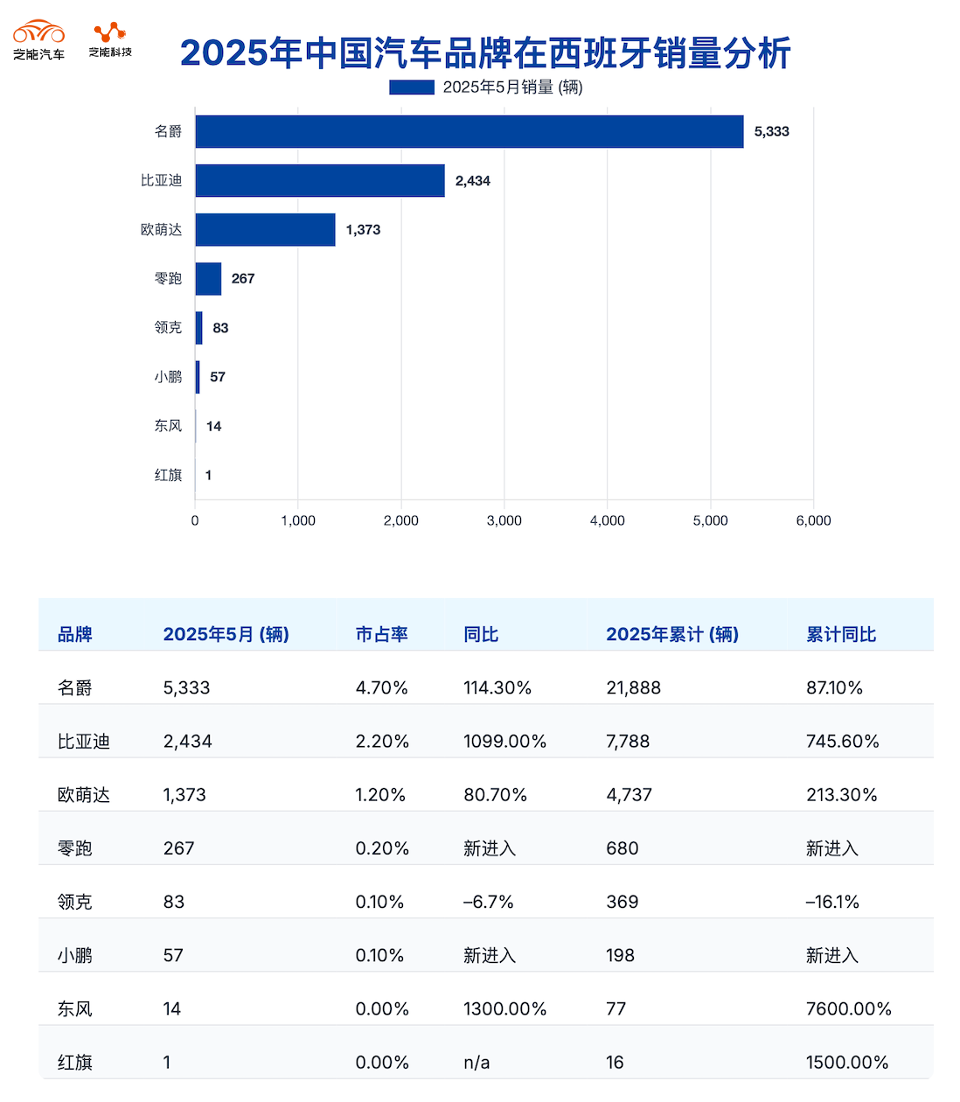European Auto Market | April 2025: Chinese Brands Accelerate Penetration in Spain
![]() 06/04 2025
06/04 2025
![]() 600
600

The Spanish market has traditionally been viewed as a relatively "conservative" segment within Europe's top five auto markets, characterized by deeply entrenched local brands and a gradual shift towards electrification.
However, in May 2025, Chinese auto brands are reshaping this narrative with a strong presence. BYD shattered records with over 2,000 monthly sales, MG cemented its position in the mainstream, and brands such as Chery, Leapmotor, and XPeng began to make deeper inroads into the sales rankings.
Driven by the wave of electrification and changes in local consumption patterns, Chinese brands are no longer mere "outsiders" but pivotal variables redefining the market's rhythm.
01
Rebounding Spanish Auto Market: Electric Penetration and Small Car Revival
In 2025, the Spanish market continued to exhibit the dual characteristics of "post-pandemic recovery and structural transformation."
In May, new car registrations reached 112,820, marking a year-on-year increase of 18.6%, the highest level for the same period since 2019. While last year's end-of-year recovery was partly policy-driven and inventory-based, the consistent nine months of year-on-year growth, coupled with double-digit increases in private consumption and leasing demand, indicate a rebound with inherent resilience.
Structurally, the market is undergoing accelerated transformation.
Combined sales of pure electric and plug-in hybrid models totaled 21,861, a year-on-year surge of 138%, capturing nearly one-fifth of the market share for the first time. This is not a coincidence but the culmination of a gradual buildup over the past three years. Shifts in consumer perception, optimized electricity price subsidies, and a diversified product offering collectively pushed this trend over the tipping point.
In terms of brand landscape, familiar themes persist: Toyota, Renault, Volkswagen, Dacia, and other established names maintain their leading positions. Among them, Dacia stands out with the Sandero, becoming the month's biggest winner with a year-on-year growth of nearly 50%. The model effectively targets both low-income families and the leasing market with its exceptional cost-effectiveness.

Yet, what truly merits attention is the rapid rise of certain marginal players—models such as MG, Citroen C4, Peugeot 208, and Clio all achieved double-digit or even triple-digit year-on-year growth. Their common traits include: small cars, electric, low-cost, high-configuration. This explains why MG ZS and BYD Seal U have achieved breakthroughs in the same dimensions.

02
BYD Breaks Through: The Real Logic Behind Chinese Brands' Penetration of Spain
From a data perspective, Chinese brands' performance in Spain is evolving from "dark horse" to "regular" status.
◎ BYD sold 2,434 units in May, a surge of 1099%, breaking through the 2% market share threshold for the first time and leaping to 19th place in the brand rankings. ◎ MG remained firmly in ninth place with sales of 5,333 units, a year-on-year increase of over 114%, and the ZS model topped the third spot in the segment's best-sellers list. This high growth is not fortuitous. The electrification process in the Spanish market lags behind markets like Norway and the Netherlands, creating a "structural gap" characterized by price sensitivity, rapidly increasing penetration rates, but a supply that has yet to fully align. BYD's Seal U, Dolphin, Seal, and other models fill this demand niche—combining the space of a mid-size SUV with a price range of 100,000 to 300,000 yuan, equipped with advanced electrification capabilities, outperforming competitors in the same price bracket in terms of energy consumption, range, and configuration.
More importantly, it's about the evolution of channel layout and brand perception.
◎ MG leveraged partnerships with established distributors in Western Europe to achieve a leverage effect, requiring lower brand investment for greater volume. ◎ BYD adopted a parallel approach of direct and semi-direct sales, supplemented by a strong presence at auto shows and offline experience centers, enhancing brand recognition while establishing price anchors and technology labels. On this map of Chinese brand distribution, MG breaks through the traditional fuel and new energy markets with a "new European" identity, BYD focuses on new energy, Chery taps into the trendy design faction with Omoda and Jaecoo, while Leapmotor, XPeng, and others test the waters of urban light users with a "technology label". This combination of "brand stratification + product stratification + strategy stratification" showcases the tactical diversity of Chinese brands in responding to overseas markets.
Of course, the current market share is far from indicating that they have "established a firm foothold," but "breaking in" has become an undeniable fact. Taking BYD as an example, the sales of a single Seal U model in May exceeded the combined total of Volvo or Jeep; and MG 3 and MG HS are also challenging the traditional strongholds of Volkswagen Polo and Renault Captur.
If the UK serves as the branding experimental field for Chinese automakers, and Norway as the test bed for technology and subsidy benefits, then Spain is the "proving ground" for structural penetration capabilities.
Here, there is no brand loyalty for German cars, nor are there high subsidies like in Nordic markets, nor is there strong local brand protection like in France.
Its consumption structure is pragmatic: extremely price-sensitive, well-developed leasing systems, a vast small car market, and electric acceptance at a pivotal point. This provides an ideal stage for Chinese brands to cut in through "price wars" and then leverage "configuration and intelligence" to execute an upward assault.
BYD's breakthrough is just the beginning, and MG's stability is but a testament to normalization. As the EU's anti-subsidy investigation into Chinese electric vehicles unfolds, the next phase of competition for Chinese brands will extend beyond merely "selling cars" to constructing a sustainable European methodology amidst rule-making, brand recognition, and continuous channel management.
Summary
The battle in Spain marks the commencement, not the conclusion, of China's entry into Europe. Whether Chinese brands can truly penetrate France, Germany, Italy, and other "European axes" hinges on their ability to move beyond the comfort zone of "product competition" and establish system capabilities in branding, trust, and technology narratives.








